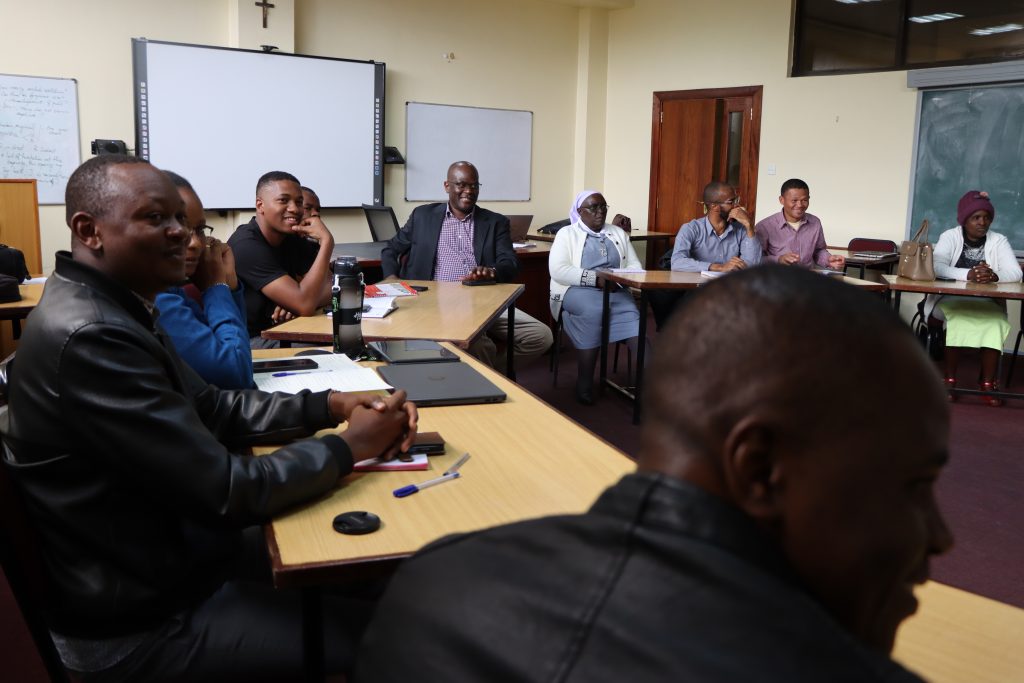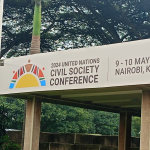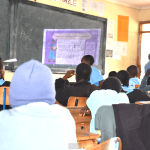By Teresia Muia – LCMC

At a recent workshop in Hipsir, ecumenical leaders from Tangaza University confronted a growing tension that could stall the Church’s bold vision for shared leadership, namely the clash between tradition-bound elders and the freedom-seeking younger generation.
As the Church strives to become a truly inclusive “Circular Church,” this generational fault line threatens to break apart the foundation of participation and unity the synod seeks to create.
On August 16th, 2025, thirty-three ecumenical leaders gathered for a reflective session that brought these underlying tensions into sharp focus. Facilitated by Dr. Elias Mokua SJ, Sr. Elisabeth Nziwa of the Catholic University of Eastern Africa, and Ms. Teresia Muia from Loyola Centre for Media and Communications, the session centered on the Final Synod Document. Together, they explored the synod’s call for a Circular Church; one rooted in inclusivity, shared decision-making, and mutual respect across generations.
A major part of the discussion delved into the complex tensions between generations within formation houses and beyond. The participants identified several critical issues fueling the divide. The older generation tends to prioritize rigidity, deeply valuing tradition, strict hierarchies, and clerical titles. Conversely, the younger generation pushes for flexibility, open dialogue, and more equal relationships that question traditional authority structures.
This clash leads to profound differences in communication styles and approaches to freedom and authority. Younger members express a strong desire for greater freedom and openness in discussions, while older leaders often hold firm to authoritative methods, creating frequent misunderstandings and conflict. These tensions also intersect with an identity crisis among younger Church members who struggle to define their role in the Church and society at large.
Such generational discord presents a tangible threat to the synodal vision. The attachment to hierarchy and tradition by older members may alienate the youth, risking fragmentation when unity and mutual respect are most needed. Without addressing these divides, the Church could find itself unable to fully embody the Circular Church ideal—one where every voice matters and collaborative mission drives the community forward.
The workshop underscored the urgent need for dialogue that bridges the generational gap, fostering respect for both tradition and innovation. Only by embracing this challenge can the Church move closer to its goal of creating a truly participatory, mission-focused community that honors all its members’ contributions.
Generational Divide Threatens Synodal Vision of Inclusive “Circular Church”
By Teresia Muia – LCMC
At a recent workshop in Hipsir, ecumenical leaders from Tangaza University confronted a growing tension that could stall the Church’s bold vision for shared leadership, namely the clash between tradition-bound elders and the freedom-seeking younger generation. As the Church strives to become a truly inclusive “Circular Church,” this generational fault line threatens to break apart the foundation of participation and unity the synod seeks to create.

On August 16th, 2025, thirty-three ecumenical leaders gathered for a reflective session that brought these underlying tensions into sharp focus. Facilitated by Dr. Elias Mokua SJ, Sr. Elisabeth Nziwa of the Catholic University of Eastern Africa, and Ms. Teresia Muia from Loyola Centre for Media and Communications, the session centered on the Final Synod Document. Together, they explored the synod’s call for a Circular Church; one rooted in inclusivity, shared decision-making, and mutual respect across generations.
A major part of the discussion delved into the complex tensions between generations within formation houses and beyond. The participants identified several critical issues fueling the divide. The older generation tends to prioritize rigidity, deeply valuing tradition, strict hierarchies, and clerical titles. Conversely, the younger generation pushes for flexibility, open dialogue, and more equal relationships that question traditional authority structures.
This clash leads to profound differences in communication styles and approaches to freedom and authority. Younger members express a strong desire for greater freedom and openness in discussions, while older leaders often hold firm to authoritative methods, creating frequent misunderstandings and conflict. These tensions also intersect with an identity crisis among younger Church members who struggle to define their role in the Church and society at large.
Such generational discord presents a tangible threat to the synodal vision. The attachment to hierarchy and tradition by older members may alienate the youth, risking fragmentation when unity and mutual respect are most needed. Without addressing these divides, the Church could find itself unable to fully embody the Circular Church ideal—one where every voice matters and collaborative mission drives the community forward.
The workshop underscored the urgent need for dialogue that bridges the generational gap, fostering respect for both tradition and innovation. Only by embracing this challenge can the Church move closer to its goal of creating a truly participatory, mission-focused community that honors all its members’ contributions.






